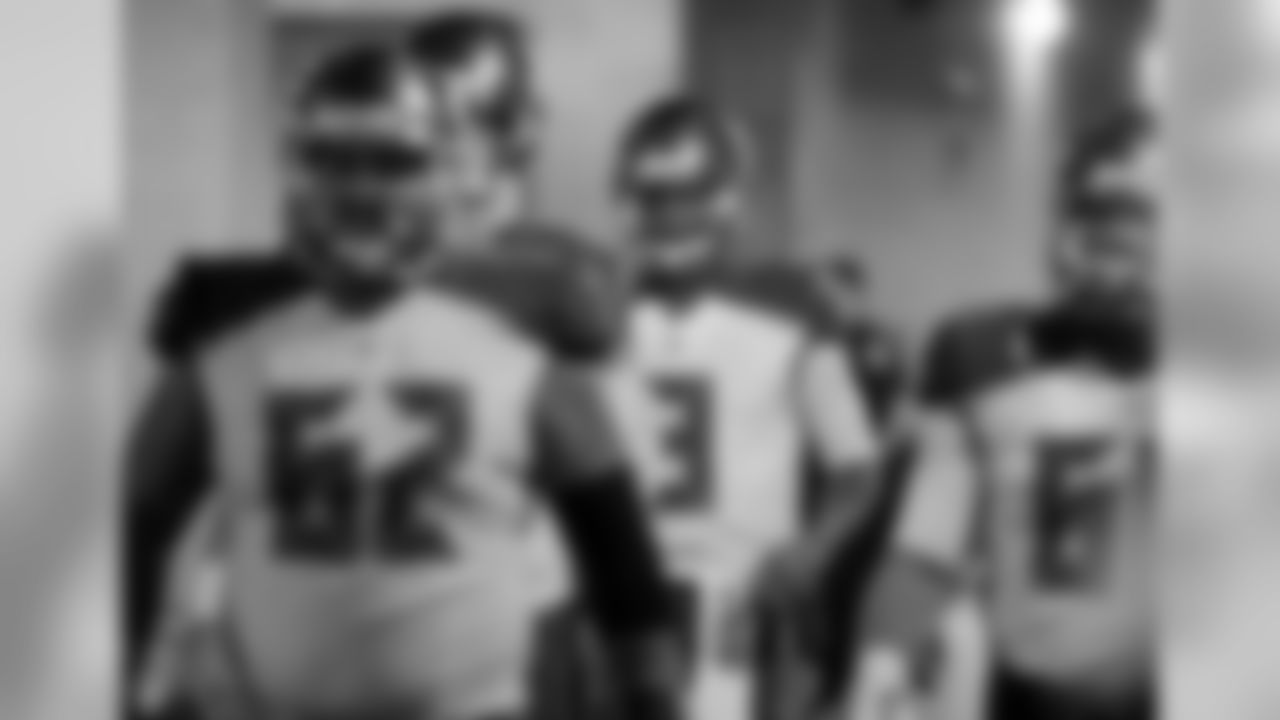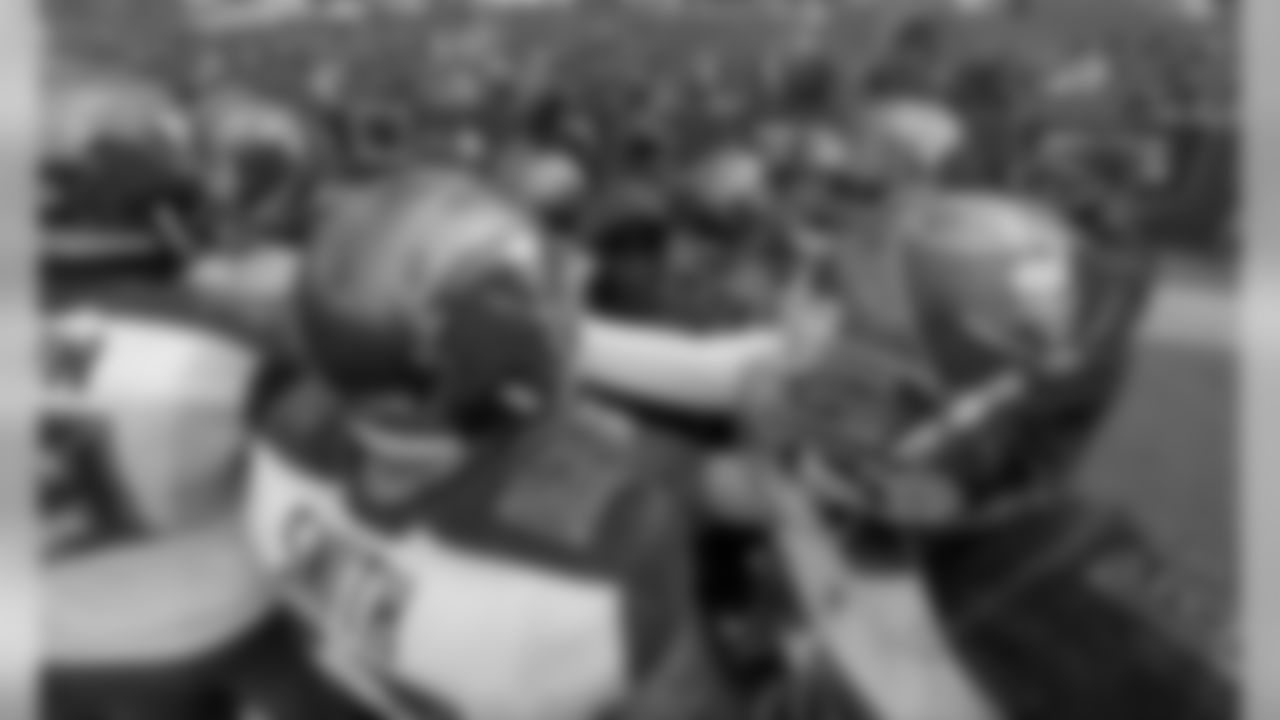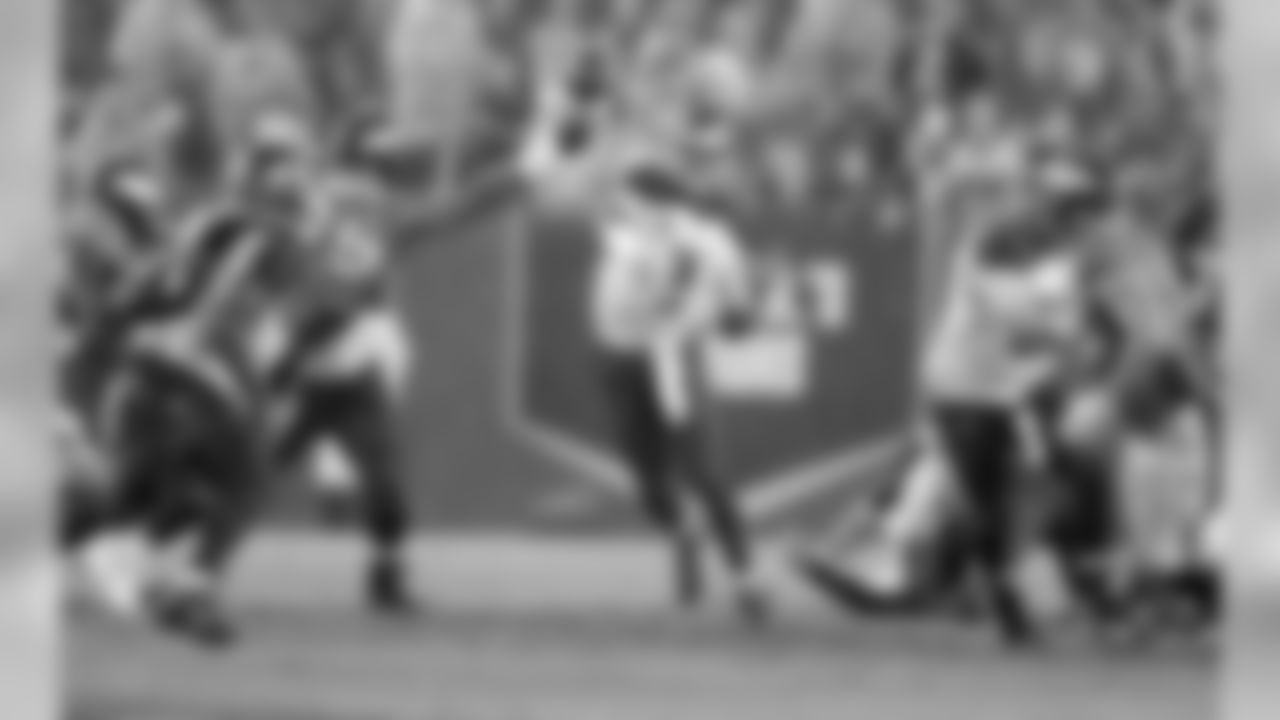After a rousing Week One win in Atlanta, the Tampa Bay Buccaneers hardly expected to finish the first quarter of the season at 1-3, two games behind those same Falcons in the NFC South standings. A defense susceptible to big plays and an offense that has committed too many turnovers have contributed to a three-game losing streak, all of which has the Buccaneers looking for a fresh start in the second quarter of the season.
A behind-the-scenes look at the Buccaneers' game against the Broncos.

Bucs vs. Broncos

28 CB Vernon Hargreaves

Bucs Fan

3 QB Jameis Winston

Bucs vs. Broncos

Bucs Fans

Bucs Fans

3 QB Jameis Winston

Bucs Fans

3 QB Jameis Winston and Quarterbacks Coach Mike Bajakian

62 C Evan Smith and #68 C Joe Hawley

98 DT Clinton McDonald

3 QB Jameis Winston

68 C Joe Hawley, #74 G Ali Marpet, and #76 T Donovan Smith

Bucs vs. Broncos

Bucs vs. Broncos

Bucs vs. Broncos

3 QB Jameis Winston

Bucs vs. Broncos

Captain Fear

Bucs vs. Broncos

8 QB Mike Glennon

76 T Donovan Smith

83 WR Vincent Jackson

83 WR Vincent Jackson

3 QB Jameis Winston

57 DE Noah Spence, #51 LB Daryl Smith, #58 LB Kwon Alexander, and #54 LB Lavonte David

Bucs vs. Broncos

Bucs vs. Broncos

Bucs vs. Broncos

Bucs vs. Broncos

Bucs Fan

83 WR Vincent Jackson, #93 DT Gerald McCoy, #74 G Ali Marpet, #3 QB Jameis Winston, and #54 LB Lavonte David

89 WR Russell Shepard, #83 WR Vincent Jackson, and #93 DT Gerald McCoy

74 G Ali Marpet and #3 QB Jameis Winston

82 TE Brandon Myers, #50 LB Josh Keyes, and #29 DB Ryan Smith

Bucs vs. Broncos

Captain Fear

Bucs Cheerleaders

Bucs vs. Broncos

3 QB Jameis Winston

Bucs vs. Broncos

3 QB Jameis Winston

Bucs vs. Broncos

Bucs vs. Broncos

98 DT Clinton McDonald

Bucs vs. Broncos

Bucs vs. Broncos

Bucs vs. Broncos

Bucs Fans

58 LB Kwon Alexander and #98 DT Clinton McDonald

Bucs Fans

Bucs vs. Broncos

Bucs Fan

Bucs Cheerleaders

Bucs Fans

Bucs vs. Broncos

Bucs vs. Broncos

Bucs Cheerleaders

Bucs Fans

Bucs vs. Broncos

68 C Joe Hawley and #74 G Ali Marpet

3 QB Jameis Winston

Bucs Cheerleader

30 S Bradley McDougald

50 LB Josh Keyes

13 WR Mike Evans
The good news, of course, is that three-quarters of the season do remain, and that a two-game deficit in the division is far from insurmountable. That's particularly true given that the Buccaneers are still 1-0 in division play and already own a road win against the current first-place team. A second division game looms next week in the spotlight of Monday Night Football, followed by a much-needed bye week.
A year ago, the Houston Texans and Kansas City Chiefs overcame 1-3 starts to make the playoffs, as did the Carolina Panthers and Philadelphia Eagles in 2013. The Buccaneers' postseason chase is far from over; in fact, it has barely begun. The obvious counterargument is that more 1-3 teams do not rebound with playoff runs over the season's final three quarters. No, there is no January guarantee for this Buccaneers team, but if they do manage to get the very young 2016 season back on track, here are some ways it might happen.
1. Get Healthy
It's at this point that you can be sure this article was not penned by a player or coach. As prevalent as injuries are in the game of football, teams steadfastly refuse to use them as excuses. 'Next man up' may be the most commonly uttered three-word phrase in the NFL, although in Tampa it's probably second behind, 'It's raining again.'
That's no surprise. The players and coaches trying to win games can't dwell on what they don't have; every week there's a new opponent with a new set of challenges for which to prepare. As coaches are fond of saying, nobody else in the league is going to feel sorry for their team. Team trainers work diligently to get injured players back on the field, but until that happens, other solutions must be found.
Of course, those solutions won't always match up to the original plan, and there are some players whose talents and contributions to the game plan are more difficult to replace. That's especially true when multiple injuries occur to the same few positions on the depth chart.
Whether or not the Buccaneers have been particularly unlucky on the health front as compared to the rest of the league, injuries have unquestionably bunched up in a way as to turn expected team strengths into question marks. Tampa Bay ranked fifth in the NFL in rushing yards per game and second in yards per carry last year and re-signed Doug Martin in the offseason to keep that core of their attack in place. The Bucs were not one of the NFL's best pass-rushing teams in 2015, but they took great pains to address that issue in the offseason and appeared to be vastly improved during the preseason.
Martin got little time to establish himself in 2016, suffering a hamstring injury in the first quarter of Week Two. Tight end Luke Stocker, the Bucs' best point-of-attack blocker and a key part of the running game, left the same game at roughly the same time. The Buccaneers began the season with five tight ends on the depth chart but may be down to two healthy ones heading into Week Five, thanks to an injury to Brandon Myers on Sunday and the Week Three release of Austin Seferian-Jenkins.
Game situations – that is, unsavory scoreboard deficits in the second half – have played a part in the Bucs' rushing problems. However, the Bucs did make an effort to run it 20 times among 42 first-half plays against Denver, just without enough success. Charles Sims and Jacquizz Rodgers have shown they can be productive parts of an overall rushing attack in the NFL, but there's little doubt the Bucs' offense will have more balance and more overall success when Martin and the banged-up tight ends return.
As for the pass-rush, it looked quite effective early on Sunday even without Robert Ayers, Jacquies Smith and George Johnson. Ayers has missed two-and-a-half games with an ankle injury and both Smith and Johnson are already on injured reserve. The Bucs dropped Denver quarterbacks four times before halftime and created a lot of long third downs, leading to only one conversion in six third-down tries for the Broncos. But Gerald McCoy suffered a calf injury, rookie Noah Spence hurt his shoulder and the Bucs were suddenly so thin up front that they gave some snaps at defensive end to linebacker Daryl Smith.
Those big plays given up by the Buccaneers' defense mentioned above have occasionally been due to breakdowns in the secondary, but it hasn't helped that opposing passers have had too much time and too many clean sight lines to get off their passes. Jacquies Smith isn't coming back this year but a return to near full-strength up front would make a big difference in the overall defensive efforts.
"I think it's too soon [to speculate]," said Head Coach Dirk Koetter of the ups and downs on the Bucs' injury report. "Again, all those guys – obviously we won't have to put an injury report out until probably Thursday this week and there's going to be some new guys on it and hopefully some of those guys that have been on it will be coming off of it."
If the Bucs do have to go to Carolina short-handed, at least they know their bye week is waiting on the other side of that trip. One can never predict how lucky or unlucky a team is going to get regarding injuries, but there's reason to believe that reinforcements are on the horizon for a Buccaneers team that could use them.
2. Solve the Turnover Problem.
The Bucs have a minor turnover problem on defense, having secured only two takeaways through four games, finishing three of those contests with none at all. They have a major turnover problem on offense, having given the ball away 11 times for a turnover ratio of -9 that ranks 31st in the league.
Of course, if reversing that issue was as simple as identifying it, it never would have become an issue in the first place. As Koetter said before Sunday's game against Denver, which turned on three first-half giveaways, every turnover has its own story. However, the most obvious and impactful place to start is with the quarterback, Jameis Winston, who has been intercepted eight times.
"Oh yeah, it needs to be discussed," said Koetter on Monday. "I have not talked to Jameis today, I'm sure I will here at some point, but it definitely needs to be discussed. And Jameis has always been fantastic about that in his time here, as far as after he sees the tape, and Jameis is always hardest on himself, his own worst critic and I'm sure he already knows that."
Winston started his rookie campaign with seven interceptions in the first four games, then made fixing that issue his top priority. He was picked off just twice in his next five outings and only 11 more times over the final 12 games. Now that concern is the top priority once again; Winston is sure to work on it but Koetter and the Bucs will also try to create more favorable situations for him.
"Some of that depends on who your next opponent is and what kind of defense they play," said Koetter. "Do we need to commit more guys to protection so he has a cleaner pocket? And at times yesterday we did have a clean pocket. Do we need to get more guys out into the route, so he does have check-downs available? And at times that is there. At that position, taking care of the football is number one priority and like I said, I thought we were past this and I was confident we were past this, but we're struggling with it right now and we've got to fix it."
The Buccaneers' 11 turnovers have resulted in 51 points for their opponents, the highest total of any team in the NFL and almost triple the league average. Opponents have started six drives in Buccaneers territory and scored on five of them; the Bucs have three such drives, with a single score to show for it. On Sunday, the Buccaneers were locked in a 7-7 tie with the Broncos in the second quarter and playing strong defense, but a turnover on a third-and-10 throw led to a short drive for the visitors and a lead they would never relinquish.
"Even if we as a team are throwing three straight incompletions and punting, that is still better, in the first half of a game, that is still better than turning the ball over and putting our defense on those short fields," said Koetter. "We're hurting ourselves, we're just not playing good complementary football, and being minus-nine on the turnover ratio for the season is killing us right now."
Obviously, the defense needs to produce takeaways, too, in order to close that gap. Still, it starts with protecting the football. If opposing teams are well ahead in the second half – as Arizona and Denver were and as even the Rams were for a stretch in Week Three – they have to take fewer risks on offense. It's complementary football, as Koetter mentioned – if the offense limits the number of times it puts the defense in tough situations, the defense will have a better chance to succeed, and that includes creating turnovers.
3. Build on Strengths.
When you're 1-3 – and when Mother Nature keeps punctuating your tough moments with game-wrecking storms – it can be hard to keep a glass-half-full mentality. The Bucs have serious performance problems to fix and injuries to overcome, but there are reasons for optimism masked by those troubles.
The run defense has been quite good, giving up very few breakaways and helping to create a good number of long third downs. That in turn has made Tampa Bay one of the better third-down defenses in the league so far. That will become more important if the Bucs stop putting themselves in tough situations with turnovers and can take advantage of making opposing offenses unbalanced. Linebackers Lavonte David and Kwon Alexander have already shown they can produce big plays, and they'll get more opportunities to do so when opposing teams have to take more risks.
With new Bucs punter Bryan Anger off to a very good start and rookie K Roberto Aguayo routinely producing kickoffs on touchbacks, the Bucs should be able to play a field-position game in the absence of turnovers. Wide receiver Adam Humphries is also proving to be an asset on punt returns, averaging more than 10 yards per runback
Mike Evans is off to his best start yet and looks capable of producing against any defense. Adam Humphries is producing out of the slot and Cameron Brate is becoming one of Winston's favorite targets. Before bogging down against Denver's Super Bowl defense, the Bucs' passing attack looked like it was on the verge of becoming one of the most productive in the league.
And as much as we focus above on getting Winston through a rash of turnover problems, his presence is clearly one of the team's strengths. The former first-overall pick threw for 4,000 yards as a rookie and was tied for the league lead in touchdown passes this year after three weeks. He has shown good mobility and vision in the pocket and can make every throw in the playbook. He's also the team's emotional leader and a tireless worker. When the run game returns and the Bucs settle into a more balanced approach on offense, Winston will be primed to lead the team to greater things.
4. Stay the Course.
Dirk Koetter is in his first season as the Bucs' head coach, though he had a very strong year as the team's offensive coordinator in 2015. Mike Smith is in his first year as the team's defensive coordinator. The Buccaneers were 6-10 a year ago and relying on a fairly young core of key players, including a second-year quarterback and a host of starters from the last three drafts.
Thanks to the retention of Koetter and that string of strong drafts, the Buccaneers certainly did not feel like a team in full transition mode in 2016. Indeed, hopes were high (and remain high) that the Bucs are primed for a series of playoff runs behind Winston and that young cast. Still, this is a team in transition to some extent, and Koetter recently spoke about the need to develop a winning culture in the Bucs' locker room.
Koetter made those comments after the Bucs dropped a 37-32 decision to Los Angeles in Week Three when it seemed like a last-minute comeback victory was within their grasp. The Bucs still need to learn how to win rather than find ways to lose in close games such as that one. That's a nebulous concept – there's no step-by-step formula for creating that culture – but Koetter still firmly believes that it exists.
Until the Bucs grasp that culture, they need to stay the course. Koetter and General Manager Jason Licht have assembled an impressive group of talent, much of it still coming into its prime. The Bucs are facing a little more adversity than they expected early in 2016, but if the players continue to believe in the system and in the level of talent around them, there's a good chance they will soon turn the corner.






















